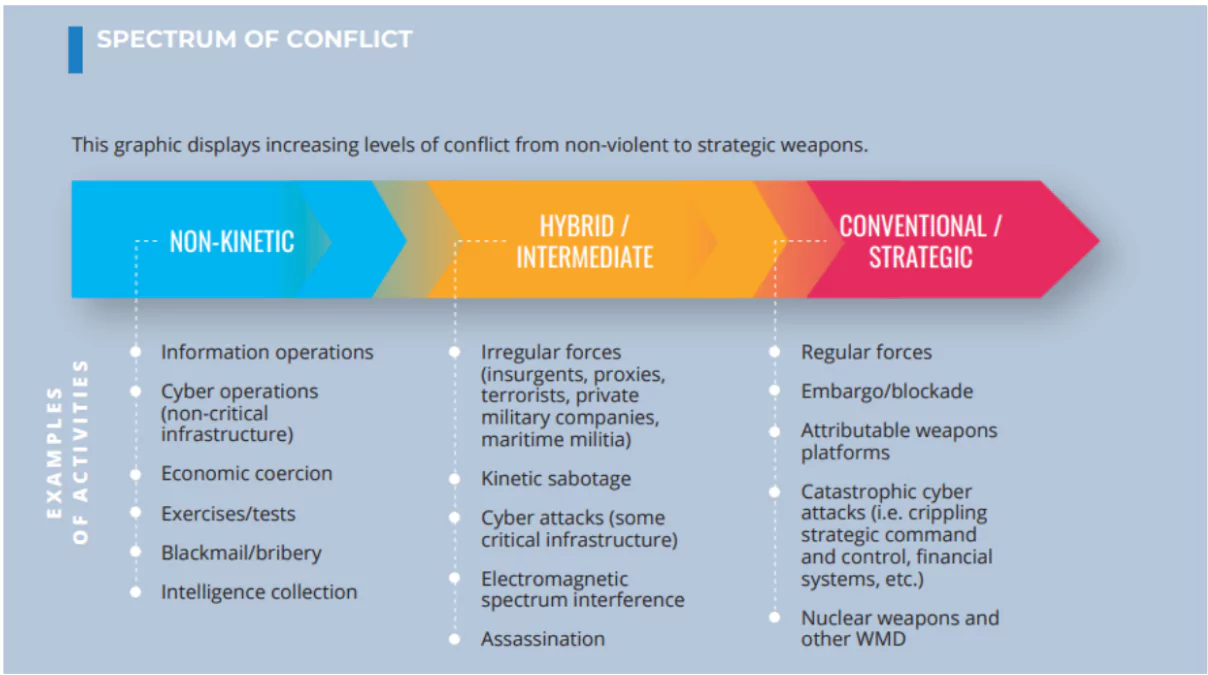The Parliamentary Standing Committee on Defence has selected 17 topics for deliberation this year, one of which focuses on the Indian armed forces’ preparedness to handle non-kinetic or hybrid warfare.
Strengthening India’s Defence: Key Focus Areas
- Hybrid Warfare Preparedness: The panel will study the armed forces’ ability to counter hybrid warfare, which combines both traditional military methods (kinetic) and modern tactics like cyberattacks (non-kinetic).
- Other topics to review
- Strategic Preparedness:
- The committee will assess the strategic preparedness of India’s armed forces, including border security and the stand-off with China at the Line of Actual Control (LAC).
- Indigenous Defence Production:
- The panel will review the progress in indigenous production of military equipment to reduce reliance on foreign imports.
- Ex-Servicemen Welfare:
- Policies related to resettlement, healthcare, and other welfare measures for ex-servicemen will also be discussed, along with assessing policies for the families of fallen soldiers.
Enroll now for UPSC Online Classes
About Non-Kinetic Warfare
Non-kinetic warfare focuses on achieving military goals without relying on physical combat or traditional weapons. Instead, it uses modern, non-physical methods.
- Non-kinetic warfare involves methods beyond traditional combat, such as electronic, cyber, and information warfare.
- It can include attacks on infrastructure like power grids and hospitals, disrupting critical systems without physical combat.
- Key Characteristics of Non-Kinetic Warfare:
- Cyberattacks:
- This involves targeting a country’s digital infrastructure, such as power grids, financial systems, or communication networks, to disrupt normal operations.
- Information Warfare:
- Manipulating information, spreading disinformation, or controlling media to influence public opinion or undermine trust in institutions.
- Psychological Operations:
- Using psychological tactics to weaken an enemy’s morale, create fear, or spread confusion among troops or civilians.
- Economic Sanctions:
- Imposing financial and trade restrictions on a country to weaken its economy and force political or military concessions without direct conflict.
Non-Kinetic Warfare vs Kinetic Warfare
| Feature |
Non-Kinetic Warfare |
Kinetic Warfare |
| Definition |
Warfare that employs methods other than physical force to achieve strategic or tactical objectives. |
Warfare that employs physical force to inflict damage or destruction on an enemy. |
| Examples |
Economic sanctions, cyberattacks, propaganda, diplomatic pressure, information warfare |
Military strikes, artillery bombardments, naval blockades, missile attacks |
| Primary Goals |
To weaken an adversary’s capabilities without direct physical confrontation. |
To inflict direct physical harm on an enemy’s forces or infrastructure. |
| Advantages |
Can be more cost-effective and less risky than kinetic warfare; can target specific vulnerabilities without causing widespread destruction. |
Can produce immediate and tangible results; can force an enemy to surrender or negotiate. |
| Disadvantages |
Can be time-consuming and difficult to achieve desired outcomes; may not be effective against determined adversaries. |
Can lead to significant loss of life and destruction; can escalate conflicts and create new enemies. |
Significance of Non-Kinetic Warfare in Modern Conflicts
- Achieving Objectives Without Direct Combat
- Non-kinetic warfare helps achieve military goals without the need for physical confrontation or traditional weapons.
- Cost-Effective Approach
- It is often more affordable than conventional warfare, as it relies on tactics like cyberattacks and information control, which require fewer resources.
- Reducing Civilian Casualties
- Since there is no direct physical conflict, this method minimizes the risk of harming civilians and causing destruction to infrastructure.
- Global Impact
- Non-kinetic tactics can be carried out from anywhere in the world, allowing nations to influence or disrupt targets across the globe.
Check Out UPSC NCERT Textbooks From PW Store
Challenges Faced by Indian Armed Forces in Preparing for Non-Kinetic Warfare
- Rapid Technology Changes
- Technology is changing quickly, allowing enemies to use new methods like cyber and electronic attacks. This makes it hard for the armed forces to keep up.
- Cybersecurity Risks
- Protecting important systems like power grids and communication networks from cyberattacks is very important.
- These attacks can harm a country without any physical fighting.
- Information Warfare
- False information and propaganda can change how people think and create problems within the country.
- It is challenging to stop these lies and keep information accurate.
- Economic and Diplomatic Challenges
- Non-kinetic warfare can include things like economic sanctions and cutting off diplomatic relations, which can weaken a country’s power and economy.
 Working with Non-Military Groups
Working with Non-Military Groups-
- Non-kinetic warfare often needs cooperation with non-military organizations, such as government agencies and private businesses, which makes teamwork essential.
- Ethical Considerations
- Economic Sanctions: These sanctions pressurize the government and can cause poverty and suffering to the general public.
- Accountability: Non-Kinetic Warfare can make it difficult to identify and attribute a specific actor which can complicate accountability and the justice system.
- Disinformation: Wrong information and propaganda used by manipulators can create a sense of fear among people and destabilize societies.
Possible Solutions
- Investing in Technology
- The armed forces should keep spending money on new technology and improving cyber defenses to stay ahead of potential threats.
- Regular Training
- The military should have regular training sessions to teach personnel about cyber and information warfare to improve their skills.
- Public Awareness Campaigns
- Educating people about false information and cyber threats can help create a stronger and more aware society.
- International Cooperation
- Working with other countries on cybersecurity and information warfare can help share intelligence and resources to tackle these issues together.
- Strong Policies and Laws
- Creating clear policies and laws to deal with non-kinetic threats can help the armed forces respond effectively and stay organized.
![]() 21 Oct 2024
21 Oct 2024
 Working with Non-Military Groups
Working with Non-Military Groups